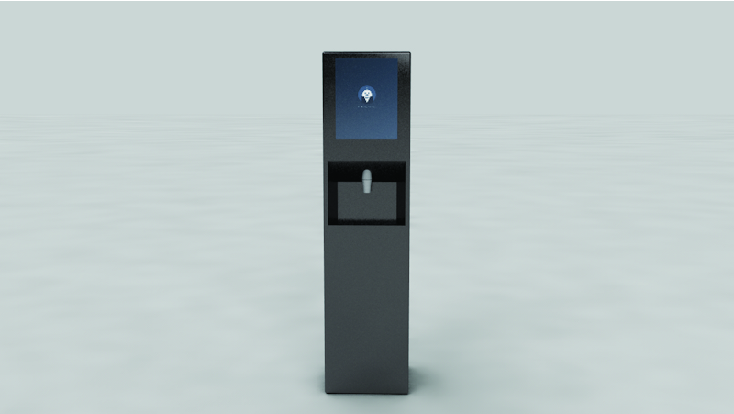- Robotics are advancing and will work with human staff
- Biometric tech will finally breakthrough into the enterprise
- The IoT will continue to be the driving force behind all technical changes
There hasn’t been one big technical breakthrough in workplace tech in 2017. Instead, we’ve seen several nascent technologies mature and move into the mainstream.
Connectivity seems to underpin this technical evolution, allowing us to seamlessly access our offices, optimise their environments and work alongside robotic coworkers. Here are the technical highlights from 2017:
Meet Your new Colleague: The Cobot

2017 was a pivotal year for Robotic Process Automation (RPA), which is an AI/automation hybrid technology that allows you to configure a “robot” to carry out simple, repetitive tasks. This “robot” is usually just a simple GUI that you can program and monitor.
The predicted impact on the workplace is a bit of a mixed bag. For example, while two-thirds of Americans believe robots will replace most human job roles in the next 50 years, research house Gartner predicts 2.3 million new jobs will be created thanks to AI, compared to the 1.8 that will be eliminated.
But RPA does have the potential to free human workers from dull, repetitive work and give employees the opportunity to upskill for more relevant roles in the future. Amazon’s warehouses have embraced RPA with their Kiva robots, which work alongside human workers to pick order items.
Any job that requires judgement, fine motor skills, creativity or unpredictability is not suited to a robot worker.
Over at the Y Media Labs offices, they developed an intelligent bartender called Niq who will recognise you when you step in front of his front-facing iPad camera, just like a normal bartender. He’ll then talk to you and will recommend a drink based on what you like. Niq’s brain resides inside an iPad app, and his body is an IoT-enabled set of motors and pumps powered by an Arduino board.
2018 looks set to be the year when collaborative robots (aka cobots) will truly move into the mainstream. There are even rumours of a corporate Alexa. And, according to a report from analyst house IDC: “By 2018, 45% of the 200 leading global ecommerce and omni-channel commerce companies will deploy robotics systems in their order fulfilment warehousing and delivery operations.”
Finally Breaking Through: Biometrics
Privacy and security concerns of biometric tech are slowly being addressed, and 2017 saw more biometric applications than ever. While the iPhone’s Face ID made waves in the consumer world, the corporate world introduced more subtle solutions. For example, Fingopay uses the unique pattern of blood vessels in your finger as a biomarker and was used at Brunel University in a payment trial.
A key application area in the workplace is access control. While technologies such as Kisi allow you to access areas of a space with the swipe of a smartphone, the next logical iteration is biometric-based access.
The biometric scanning industry is growing fast; and is predicted to be worth more than $32 billion by 2022, research reveals. Companies including Eyelock, Face Value Technologies, Kaliber Labs and Synel America are already integrating biometrics into the workplace. 2018 could be the year we see more widespread adoption of biometric tech.
Bringing it all Together: The IoT and Smart Offices

The Internet of Things (IoT) has been one of those buzzwords that keeps on popping up. But, in 2017, we started to see real progress in smart offices arena.
In an IoT-enabled office (aka smart office), everything is connected to the internet and feeds a continuous stream of data to a repository so everything from the temperature to the kettle can be controlled remotely and/or autonomously.
The IoT is the connecting technology to facilitate Big Data analysis, improve AI and, fundamentally, overhaul our working environments.
Smart buildings could save the UK economy an estimated £135 bn per year due to increases in productivity and reduced medical costs alone. Employees in eco-friendly smart buildings are apparently 16% more productive than traditional offices because the resources and rooms are used as effectively as possible to streamline the working day for the workforce.
Almost half of workers in Asia Pacific and Japan (APJ) expect to be working in a smart office by 2021, research reveals. Exactly what constitutes a “smart” office as opposed to an office with smart tech is still up in the air. But 2018 looks set to be the year when we go beyond baffling applications such as smart forks (I’m not exaggerating – check this out) and a ubiquitous IoT-enabled smart office.
And one for the future: 5G
There are a handful of technologies poised for world domination next year, but ultrafast 5G networks could transform workspaces around the world. This year, we saw various network providers unveil their plans for 5G, which is due for commercial release in the early 2020s.
That may sound a long way off but 5G-based tech is already being developed to overhaul our wireless networks and connectivity. 2018 will be the year when these ideas start to mature into more definitive use cases. 5G is definitely one of watch in the New Year and in the years ahead.
What technologies have you used in 2017 or do you think will snowball in 2018? Let us know in the comments below.


 Dr. Gleb Tsipursky – The Office Whisperer
Dr. Gleb Tsipursky – The Office Whisperer Nirit Cohen – WorkFutures
Nirit Cohen – WorkFutures Angela Howard – Culture Expert
Angela Howard – Culture Expert Drew Jones – Design & Innovation
Drew Jones – Design & Innovation Jonathan Price – CRE & Flex Expert
Jonathan Price – CRE & Flex Expert













